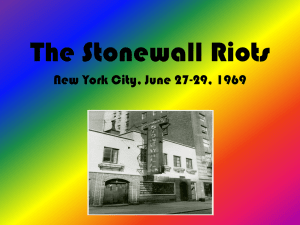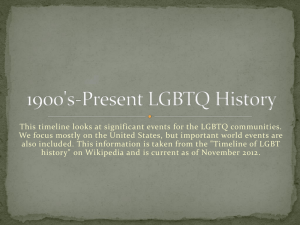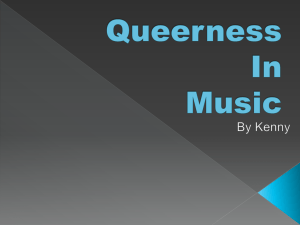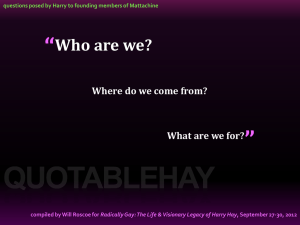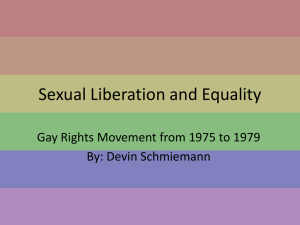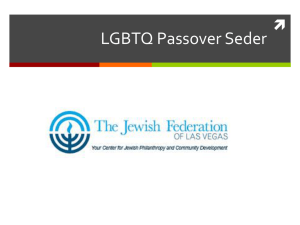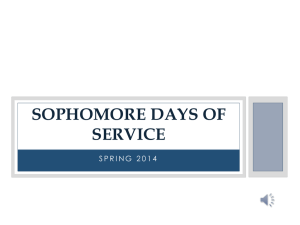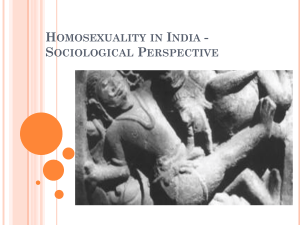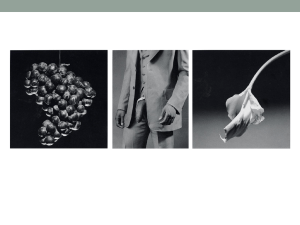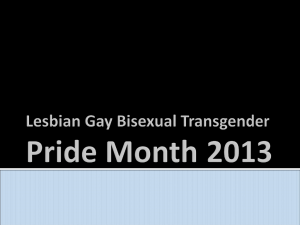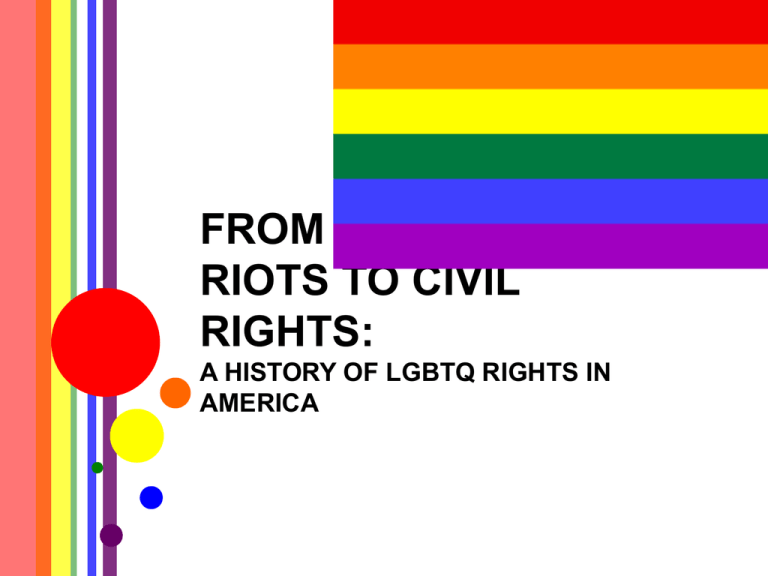
FROM THE STONEWALL
RIOTS TO CIVIL
RIGHTS:
A HISTORY OF LGBTQ RIGHTS IN
AMERICA
COMMON CORE ALIGNMENT
RH.9-10.2. Determine the central ideas or
information of a primary or secondary source;
provide an accurate summary of how key events or
ideas develop over the course of the text.
RH.9-10.9. Compare and contrast treatments of the
same topic in several primary and secondary
sources.
RH.9-10.10. By the end of grade 10, read and
comprehend history/social studies texts in the
grades 9–10 text complexity band independently
and proficiently.
WHST.9-10.9. Draw evidence from informational
texts to support analysis, reflection, and research.
OBJECTIVE
Students will be able to:
Identify key terms related to the events of the Stonewall
Riots of 1969 and the struggle for lesbian, gay,
bisexual, transgender, and queer/questioning rights
in the United States.
Describe the events that sparked the LGBTQ rights
movement in the United States.
Compare and contrast the movement for LGBTQ rights
in the United States with other civil rights struggles in
American History.
Evaluate the likelihood that the LGBTQ rights
movement will achieve its objectives based on primary
source evidence and the student’s prior knowledge of
civil rights struggles in United States history.
AGENDA
Video Activity: The Stonewall Inn, Birth of the Gay
Rights Movement (10)
Defining Our Terms: LGBTQ Alphabet Soup (20)
Introduction to New Material: Timeline Activity, LGBTQ
Rights from 1940 to the Present (20)
Test Your Knowledge: Quick Review Quiz (10)
Video Activity: Combating Hate and Homophobia (15)
Guided Practice: Compare and Contrast, Civil Rights
Struggles in American history (30)
Video Activity: LGBTQ Rights in A Modern Context (15)
Independent Practice: Document Based Question (60)
Closing (5)
INTRODUCTORY VIDEO
Directions: You will now watch a short introductory
video clip designed to familiarize you with the start
of the gay rights movement.
This video describes the events that took place on
June 26, 1969 at the Stonewall Inn, a gay bar and
lounge located in the Greenwich Village
neighborhood of New York City.
The riots that took place in the days that followed
are known as the Stonewall Riots and are
considered by many experts to be the start of the
LGBTQ rights movement in the United States.
VIDEO
Gay Rights Introduction
LBTQ ALPHABET SOUP:
DEFINING OUR TERMS
Directions: The next few slides are designed to
acquaint you with common terms related to the
struggle for gay or LGBTQ rights. As you read each
slide be sure to take note of the key definitions.
There will be a brief quiz over these terms before
you begin the next activity.
LGBTQ: Refers to lesbian, gay, bisexual,
transgendered, and queer/questioning individuals
or groups.
LBTQ ALPHABET SOUP:
DEFINING OUR TERMS
Ally: A person who identifies as heterosexual or
straight but supports the rights of homosexuals.
LBTQ ALPHABET SOUP:
DEFINING OUR TERMS
Bisexual: A term for men or women who identify
themselves as being attracted to both other men
and other women.
LBTQ ALPHABET SOUP:
DEFINING OUR TERMS
Civil Union: A form of partnership granted by a
local, state, or national government that recognizes
the relationship between two individuals. This may
or may not be similar to a marriage and the rights of
individuals in a civil union may be the same or less
than those in a state-sponsored marriage. In the
United States there are several states where civil
unions are available to same-sex couples but these
unions do not provide the same benefits of
marriage because of existing federal law.
LBTQ ALPHABET SOUP:
DEFINING OUR TERMS
Closeted: Refers to individuals who are not open
about their sexuality.
LBTQ ALPHABET SOUP:
DEFINING OUR TERMS
“Coming Out” (of the Closet): the time when a
person chooses to reveal their sexual orientation to
other people. This is often done in stages; for
example people may tell their family and friends of
their orientation but not their employers or may
choose to withhold information from people whom
they do not view as accepting.
LBTQ ALPHABET SOUP:
DEFINING OUR TERMS
Defense of Marriage Act: A law signed by President
Bill Clinton in 1996 that says that the federal
government will not recognize any marriage other
than those between one man and one woman for
the purposes of federal benefits. This means that
LGBTQ people do not have access to 1049 federal
programs and supports that heterosexual married
people automatically enjoy including such benefits
as: social security survivor benefits, visa benefits
and access to veterans’ pensions.
LBTQ ALPHABET SOUP:
DEFINING OUR TERMS
Domestic Partnership: A registered form of
cohabitation that may be similar to or different from
a civil union. Individuals, both straight and gay, who
enter into domestic partnerships are not married but
have indicated that they have a partner. In some
states this allows straight and gay couples who are
not married to enjoy some of the benefits of
marriage such as sharing health insurance or
transferring property from one person to another
without tax penalties.
LBTQ ALPHABET SOUP:
DEFINING OUR TERMS
Don’t Ask, Don’t Tell: A law signed by President Bill Clinton in
1993 and repealed by President Barack Obama in 2010 that
barred LGBTQ from openly serving in the United States
military. When the law was in effect, a commanding officer or
fellow officer was not allowed to ask a person in the military if
he or she was gay, lesbian, or bisexual (don’t ask). LGBTQ
people were not allowed to openly discuss their sexuality or
reveal to anyone that they were gay (don’t tell). In practice
thousands of people were discharged from the military under
the policy if it was found that they had communicated their
sexuality in any way to anyone such as emailing, calling, or
social networking with a partner or attending events or places
frequented by LGBTQ individuals. Under the new policy
lesbian, gay, and bisexual men and women will be allowed to
serve openly. Transgendered individuals are still not legally
allowed to serve in the military.
LBTQ ALPHABET SOUP:
DEFINING OUR TERMS
Drag Queen: A person who dresses in the clothing
style of the opposite sex for the purposes of
entertainment. This is different than a
transgendered person who dresses permanently
and attempts to live as the opposite gender. Drag
queens typically perform in “drag” but live their lives
as their identified gender.
LBTQ ALPHABET SOUP:
DEFINING OUR TERMS
Employment Non-Discrimination Act: A proposed
law that would prevent discrimination based on
one’s sexual orientation or gender identity. Some
states already offer this protection but many do not.
In states where the protection does not currently
exist and employee can be fired simply for being
gay, lesbian, bisexual, or transgendered.
LBTQ ALPHABET SOUP:
DEFINING OUR TERMS
Ex-Gay Movement: A movement among certain
individuals and organizations, largely based on
religious ideas, that suggests that being gay is
simply a “phase” or a “sickness” that can be cured
through therapy. This movement is highly
controversial and the American Psychiatric
Association has said, along with numerous other
medical organizations that being gay is not a
“disease”, that homosexuality occurs among
humans and many animal species, and that there is
no “cure” for being gay.
LBTQ ALPHABET SOUP:
DEFINING OUR TERMS
Gay: A term for men who identify themselves as
being attracted to other men. This term may
sometimes be applied more broadly to refer to
anything related to the LGBTQ community.
LBTQ ALPHABET SOUP:
DEFINING OUR TERMS
Gay Rights Organization: An organization that
works to promote the rights of LGBTQ individuals
and combat hate and homophobia through
programming aimed at many communities in the
United States and around the world. Some
prominent past and present LGBTQ organizations
include: The Human Rights Campaign, GLAAD
(The Gay and Lesbian Alliance Against
Defamation), GLSEN (The Gay, Lesbian, and
Straight Education Network), PFLAG (Parents
Friends, and Families of Lesbians and Gays), and
ACT UP.
LBTQ ALPHABET SOUP:
DEFINING OUR TERMS
Gender Reassignment Surgery: The process
whereby a transgendered person surgically
changes his or her sex to fit his or her gender
identity.
LBTQ ALPHABET SOUP:
DEFINING OUR TERMS
GSA: A Gay-Straight Alliance is an organization
based in a school, typically in a college or university
setting or in a high school, to support tolerance and
acceptance of LGBTQ individuals and to combat
homophobia and bullying.
LBTQ ALPHABET SOUP:
DEFINING OUR TERMS
HIV/AIDS: Human Immunodeficiency Virus or
Acquired Immunodeficiency Syndrome, a disease
that has impacted over 40 million people globally.
First called “gay cancer” or “gay disease” it was
originally thought to only affect gay people. This
was later disproven, HIV/AIDS can be transmitted
to people of any sexual orientation. HIV/AIDS
destroys a body’s immune system often leaving a
person susceptible to other diseases and, without
medical treatment, can lead to severe medical
problems and, in some cases, death.
LBTQ ALPHABET SOUP:
DEFINING OUR TERMS
Homophobia: An irrational fear by individuals,
organizations, or governments of people who are or
are suspected to be gay, lesbian, bisexual,
transgendered, or questioning that is sometimes
typified by intolerance or negative views of LGBTQ
people and the desire to limit the rights of these
individuals.
LBTQ ALPHABET SOUP:
DEFINING OUR TERMS
Homosexuality: A term that broadly applies to
individuals who are attracted either in whole or in
part to people of the same sex or gender and
choose to identify themselves this way.
LBTQ ALPHABET SOUP:
DEFINING OUR TERMS
Lesbian: A term for women who identify themselves
as being attracted to other women.
LBTQ ALPHABET SOUP:
DEFINING OUR TERMS
Mattachine Society: An early LGBTQ rights
organization based in New York City that sought to
provide a meeting place for LGBTQ people in order
to organize for basic rights and protect against
police brutality.
LBTQ ALPHABET SOUP:
DEFINING OUR TERMS
Pride: Refers to the movement that developed after
the Stonewall Riots to encourage gay, lesbian,
bisexual, and transgendered people to live openly.
LBTQ ALPHABET SOUP:
DEFINING OUR TERMS
Queer: A term used by individuals who see
themselves as not exclusively heterosexual but do
not wish to label themselves as either gay, lesbian,
bisexual, or transgendered.
LBTQ ALPHABET SOUP:
DEFINING OUR TERMS
Questioning: A term used by individuals who feel
that they may possibly be homosexual but are not
certain that this is the case, thus they are in the
process of questioning their sexuality.
LBTQ ALPHABET SOUP:
DEFINING OUR TERMS
Same-Sex Attraction: A derogatory term often used
by organizations such as the “ex-gay movement”
and individuals who believe that homosexuality is
either a phase or can be cured to suggest that this
“attraction” can be overcome either through therapy
or prayer.
LBTQ ALPHABET SOUP:
DEFINING OUR TERMS
Stonewall: Refers to riots that took place near the
Stonewall Inn in Greenwich Village, New York City,
a bar for LGBTQ people, on June 28, 1969 after
local police raided the bar and repeatedly harassed
its patrons leaving many wounded and arrested and
one person dead.
LBTQ ALPHABET SOUP:
DEFINING OUR TERMS
Transgendered: A person who identifies themselves
as the opposite gender from their physical body.
These individuals may live as transgendered
people or may choose to use gender reassignment
surgery to become a transsexual and match their
outward body to their gender identities.
LBTQ ALPHABET SOUP:
DEFINING OUR TERMS
Transsexual: A person who seeks to actively
change their physical sex to match their gender
identity.
TEST YOUR KNOWLEDGE
LGBTQ ALPHABET SOUP QUIZ
1.
What year did the events at the Stonewall Inn take
place?
A: 1969
2.
What is an ally?
A: A person who supports LGBTQ rights / someone who is
against homophobia
3.
What is one LGBTQ organization in schools?
A:GSA / Gay-Straight Alliance
4.
What is the Defense of Marriage Act?
A: A law that prevents the federal government from
recognizing gay marriage.
5.
What does the “Q” in LGBTQ stand for?
A: queer or questioning
INTRODUCTION TO NEW MATERIAL:
TIMELINE NOTES DIRECTIONS
Directions: The timeline of LGBTQ rights is divided
into 3 eras:
Pre-Stonewall (1600-1969)
The Stonewall Riots (1969-70)
Post-Stonewall (1971-Present)
As you read the timeline of events in the LGBTQ
rights movement pay close attention to how the
events of the Stonewall Riots led to the creation of
new organizations and new ways of thinking about
lesbians, gays, bisexuals, and transgendered
people.
There will be a short quiz following this activity.
PRE-STONEWALL (1600-1969)
1920 - “Gay” first used to refer to homosexuals in the
publication Underground
1933 - Hitler bans gay and lesbian groups, burns the
Institute of Sexual Science library
1935 - “Successful” electric shock therapy treatment of
homosexuality reported at American Psychological
Association meeting
1941 - “Transsexuality” first used in reference to
homosexuality and bisexuality
1942 - Switzerland decriminalizes adult homosexuality
1943 - U.S. military bars gays and lesbians from serving
in the Armed Forces
1945 - Revealed that Holocaust victims include LGBTs
1945 - The Quaker Emergency Committee of New York
City opens the first social welfare agency for gay people
PRE-STONEWALL (1600-1969)
1945 - First known female-to-male sex
reassignment surgery, on Michael Dillon in Britain
1948 - The Kinsey Report says homosexual
behavior among men is widespread
1948 - Hollywood begins blacklisting suspected
homosexuals
1951 - The Mattachine Society is founded to give
a voice to LGBTQ people in New York politics
1952 - Immigrants banned from U.S. if they have
“psychopathic personality,” including homosexuality
1953 - President Dwight D. Eisenhower orders
dismissal of all federal employees guilty of “sexual
perversion”
PRE-STONEWALL (1600-1969)
1954 - Dr. Evelyn Hooker presents a study showing gay
men are as well adjusted as straight men, at an
American Psychological Association meeting
1961 - First openly gay person runs for U.S. public office
(drag queen Jose Sarria, running for San Francisco city
supervisor)
1962 - Illinois becomes first state to make consensual
same-sex acts legal
1963 - American Civil Liberties Union opposes
government interference in the private sex lives of
consenting adults
1966 - First U.S. gay community center opens, in San
Francisco, led by The Society for Individual Rights
1969 - National Institute of Mental Health study chaired
by Dr. Evelyn Hooker urges decriminalization of private
sex acts between consenting adults
THE STONEWALL RIOTS (JUNE 28,
1969)
1:20am - In the morning on Saturday, June 28, 1969,
four plainclothes policemen in dark suits, two patrol
officers in uniform, and Detective Charles Smythe and
Deputy Inspector Seymour Pine raid the Stonewall Inn,
a gay bar in Greenwich Village, New York City
1:45am - Police begin sending bar patrons outside and
within minutes there are hundreds of people on the
street waiting for arrest
2:00am - An officer shoved a transsexual who reacted
by hitting him in the head
2:05am - Bar patrons began throwing bottles and rocks
at the police shouting “Gay Power” and singing “We
Shall Overcome”
4:00am - Rioters disperse after pushing the police out of
the neighborhood
THE STONEWALL RIOTS (1969 - 1970)
Thousands of people crowded into the Stonewall Inn and onto
Christopher Street in front of the bar the night after the riot
People began mass chanting with gay power slogans and
wrote graffiti such as “Support Gay Power” and “Legalize Gay
Bars”
The riots continued for several more days with differing
crowds each evening
Protesters began to organize in local homes to campaign for
recognition of gay rights
Within a year the Gay Liberation Front and the Gay
Activists Alliance were formed to demonstrate for the rights
of LGBTQ people
On June 28, 1970 on the one year anniversary of the riots the
first Gay Pride Parade was held on Christopher Street in front
of the Stonewall Inn sparking the birth of the modern LGBTQ
rights movement
POST-STONEWALL (1970-PRESENT)
1970 - First Gay Liberation Day March held in New York
City, First Gay Freedom Day March held in Los Angeles,
first Gay-in held in San Francisco
1972 - Sweden becomes first country in the world to
allow transgendered people to legally change their sex,
and provides free hormone therapy. Norway
decriminalizes homosexuality
1972 - Ann Arbor, Michigan becomes first city in United
States to pass gay rights ordinance
1973 - The American Psychiatric Association removes
homosexuality from its DSM-II Diagnostic and Statistical
Manual of Mental Disorders, based largely on the
research and advocacy of Evelyn Hooker
POST-STONEWALL (1971-PRESENT)
1977 - Harvey Milk is elected city-county supervisor in
San Francisco, becoming the third out American elected
to public office
1977 - Dade County, Florida enacts a Human Rights
Ordinance; it is repealed the same year after a militant
anti-gay-rights campaign led by Anita Bryant
1978 - The first Gay Pride Flag is flown in San Francisco
1978 - San Francisco Supervisor Harvey Milk and
Mayor George Moscone are assassinated by former
San Francisco Supervisor Dan White.
1979 - First national gay rights march on Washington,
DC
1980 - The Democratic National Convention becomes
the first major political party in America to endorse a gay
rights platform plank.
POST-STONEWALL (1971-PRESENT)
1980 - Ronald Reagan is elected President
1980 - Moral Majority starts anti-gay crusade nationwide
1981 - The first cases of AIDS (then called GRID) are
confirmed in the United States
1983 - Massachusetts Representative Gerry Studds reveals
he is a homosexual on the floor of the House, becoming the
first openly gay member of Congress
1985 - President Reagan mentions AIDS publicly for the first
time, by then 25,000 Americans have died from the disease
1987 - ACT UP stages its first major demonstration against
the government for failing to stop the spread of HIV/AIDS
1987 - U.S. Congressman Barney Frank comes out as gay
1989 - Denmark is first country in the world to enact registered
partnership laws (like a civil union) for same-sex couples,
with most of the same rights as marriage
POST-STONEWALL (1971-PRESENT)
1992 - The World Health Organization removes
homosexuality from its list of disorders
1994 - American Medical Association denounces
the ex-gay movement and supposed cures for
homosexuality saying it is not a disease
1998 - Matthew Shepard is beaten and left for dead
on a fence in Laramie, Wyoming for being gay
2000 - Vermont becomes the first US state to allow
civil unions
2001 - Maryland passes an employment nondiscrimination act and outlaws discrimination
against LGBTQ people in employment
POST-STONEWALL (1971-PRESENT)
2003 - In Lawrence v. Texas (2003) the US
Supreme Court outlaws anti-sodomy laws and says
relations between two consenting adults are legal
2003 - Massachusetts becomes the first state to
legalize same-sex marriage while 11 other states
pass bans on such marriages later in the year
(today 39 states have bans)
2005 - Iran begins widespread execution of gays
2008 - Gay marriage legalized in California and
Connecticut
2008 - Proposition 8 makes gay marriage illegal in
California again on the same day Barack Obama is
elected
POST-STONEWALL (1971-PRESENT)
2009 - Gay marriage legalized in Iowa and
Vermont
2010 - Gay marriage in New Hampshire and
Washington DC
2010 - Illinois legalizes civil unions
2010 - A judge rules that Arkansas’ ban on adoption
by same-sex couples is unconstitutional
2010 – President Barack Obama signs a repeal of
Don’t Ask, Don’t Tell which will allow LGB people
to serve openly in the military, transgendered
people are still not allowed to serve in the military
2011 - Hawaii and Delaware legalize civil unions
2011 - New York legalizes same-sex marriage
TEST YOUR KNOWLEDGE:
A QUICK REVIEW QUIZ
1.
2.
3.
4.
5.
6.
7.
8.
9.
10.
What was the major cause of the Stonewall Riots?
What LGBTQ organization existed before the Riots?
Name 3 states that currently allow same-sex marriage.
What is the significance of the Supreme Court case
Lawrence v. Texas (2003)?
When was HIV/AIDS first confirmed in the US?
What was the focus of Dr. Evelyn Hooker’s research?
What San Francisco politician was assassinated
because of his homosexuality in 1978?
Which country first decriminalized homosexuality in
1942?
Who opened the first social welfare agency for gay
people?
What did activists do to commemorate the first
anniversary of the Stonewall Riots?
“IT GETS BETTER” COMBATING HATE
AND HOMOPHOBIA
Directions: You will watch a short video clip that
addresses the issue of homophobia and bullying in
our nation’s schools. This is a serious issue and the
Baltimore City Public Schools is working to combat
bullying and create a safe space for all of our
students.
After you watch the video answer the 6 guiding
questions that accompany this clip in order to frame
your thinking about respect in our schools.
Video
“It Gets Better”
POST VIDEO QUESTIONS
1.
2.
3.
4.
5.
6.
What is the overall message of the “It Gets Better”
video?
Without identifying names, what incidents of bullying,
harassment, racism, sexism, or homophobia have
you seen at your school?
What can students do to prevent this kind of behavior?
What can schools do to prevent this kind of behavior?
What can our communities and our nation do to
prevent this kind of behavior?
Why is it important to treat people with respect even if
you disagree with something about who they are or
what they do?
GUIDED PRACTICE:
COMPARE AND CONTRAST DISCUSSION
How are the Stonewall Riots similar to or different
from other struggles for civil rights?
Directions:
Create a compare/contrast Venn Diagram about several
ways that the LGBTQ Rights Movement is similar to and
different from the Civil Rights movement led by African
Americans, Latinos, and Asians that you have already
studied.
Next, use the answers from your Venn diagram to help
you answer the 6 discussion questions about civil rights
struggles in American history.
VENN DIAGRAM – SIMILARITIES AND
DIFFERENCES
LGBTQ Rights Movement
Other Civil Rights Movements
DISCUSSION QUESTIONS
1.
2.
3.
4.
5.
6.
What rights are the people that we have seen on film
and in pictures looking to get?
What is stopping them from achieving their goals; why
do they need to fight for their rights?
What groups in history do you already know about who
have struggled to gain freedom or equality?
In what ways are the struggles that LGBTQ people
have gone through in America similar to these
experiences?
In what ways are the struggles that LGBTQ people
have gone through in America different from these
experiences?
What do you think the struggles that these groups
have gone through in our history says about America
and the experience of different groups in our country?
VIDEO ACTIVITY:
LGBTQ RIGHTS IN A MODERN CONTEXT
Directions: After you watch the 2 video clips answer
the questions that accompany the videos to guide
your understanding of how gay rights issues have
changed in modern America.
Videos
NY Gay Marriage
Proposition 8
VIDEO QUESTIONS
1.
2.
3.
4.
What events have occurred most recently in the
LGBTQ rights movement?
What federal law makes it difficult for same sex
couples who get married in one state to remain
married if they move to other states?
Why do you think the outcome of these events
might have been so different in New York and
California?
Based on what you know about government
already, who do you think should decide if LGBTQ
people should be allowed to get married, the
courts, the legislatures, the president, or the
people? Why?
INDEPENDENT PRACTICE:
DOCUMENT BASED QUESTION
Directions: The following question requires you to construct a
coherent essay that integrates your interpretation of Documents A
– I and your knowledge of the period referred to in the question.
High scores will be earned only by essays that both cite key
pieces of evidence from the documents and draw on outside
knowledge of the period. Some of the documents have been
edited, and wording and punctuation have been modernized.
(Rampolla 57)
Suggested Writing Time: 60 Minutes
Describe how the main goals of the LGBTQ rights movement have
changed from its inception in 1969 to the present?
Explain what changes in public policy individuals who participated in
the Stonewall Riots were hoping to achieve in 1969.
Explain how LGBTQ organizations’ priorities shifted in the wake of the
1980’s conservative movement and the advent of HIV/AIDS.
Describe the modern (post 2000) LGBTQ rights movement and
characterize the movement’s goals and ambitions.
Evaluate whether this movement is likely to achieve its goals based
on its current strategy and your prior knowledge of civil rights
struggles in the United States.
RUBRIC
DOCUMENT
A
DOCUMENT B
DOCUMENT B VIDEO CLIP
“ACT UP”
DOCUMENT C
The Stonewall Inn in New York City's West Village June 28, 1969
"Standing Up for Gay Rights"
It was 1:20 a.m. when eight cops stomped into the Stonewall Inn, a dive in
Manhattan's Greenwich Village district that had no liquor license but served
watery drinks to a mix of drag queens, street kids, gay professionals and
closeted and straight mafiosi (who ran the place). Within two hours, the
Village was bleeding and burning as hundreds rioted. How did the nightly
saturnalia at Stonewall produce protests that would kick start the modern gayrights movement?
The uprising was inspirited by a potent cocktail of pent-up rage (raids of gay bars
were brutal and routine) and overwrought emotions (hours earlier, thousands
had wept at the funeral of Judy Garland). As a 17-year-old cross-dresser was
being led into the paddy wagon and got a shove from a cop, she fought back.
"[She] hit the cop" one of her friends later told Martin Duberman, author of the
history of Stonewall. Later, the deputy police inspector in charge would
explain that day's impact: "For those of us in [the] public morals [division],
things were completely changed ... Suddenly they were not submissive
anymore." Today gays and lesbians memorialize that night each year with a
weekend of rallies, parades and parties—a spectacle as inspiring as the
Stonewall itself. - John Cloud, Time Magazine
DOCUMENT D
DOCUMENT E
Document E
“Gay Marriage: Why Judge Walker Got Proposition 8
Ruling Wrong”
DOCUMENT F
DOCUMENT G
Document G
“California Should Get Back in Gear on Gay
Marriage”
DOCUMENT H
VIDEO
Document H
Stonewall Uprising Trailer
ANSWER SPACE
Type your answer to your Document Based
Question essay in this space:
CONCLUSION VIDEO
Gay Rights Closing Video
CONCLUSION
Please be sure to clean up your materials, turn in
any appropriate work (if applicable) to your teacher,
and to leave your space in a tidy fashion.
Questions to think about as we conclude the lesson
and in the future:
What does the term equality mean in an American
context? (Have we achieved equality in America?)
What can we learn about the ability of people to change
their society by looking at events like the Stonewall
Riots and other civil rights struggles?
What direction will our country take in the future in terms
of treating all people fairly; should this be a national
priority for our citizens and our leaders?
Thank you!

